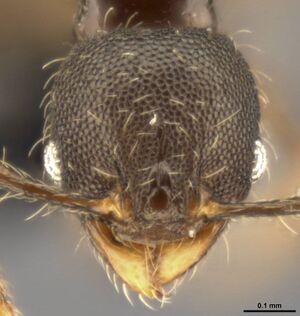Pheidole multispina
| Pheidole multispina | |
|---|---|

| |
| Scientific classification | |
| Kingdom: | Animalia |
| Phylum: | Arthropoda |
| Class: | Insecta |
| Order: | Hymenoptera |
| Family: | Formicidae |
| Subfamily: | Myrmicinae |
| Tribe: | Attini |
| Genus: | Pheidole |
| Species: | P. multispina |
| Binomial name | |
| Pheidole multispina Wilson, 2003 | |
In Costa Rica, Longino (1997). found a colony nesting in a flat cavity beneath loose bark on top of a rotten log; and in Panama, Alfred E. Emerson found it in small cavities inside a rotten log. (Wilson 2003)
Identification
See the description in the nomenclature section.
Keys including this Species
Distribution
Occurs in tropical forests in Panama and, according to Longino (Longino 1997), the southwestern lowlands of Costa Rica.
Latitudinal Distribution Pattern
Latitudinal Range: 9.4857096° to 8.407045°.
| North Temperate |
North Subtropical |
Tropical | South Subtropical |
South Temperate |
- Source: AntMaps
Distribution based on Regional Taxon Lists
Neotropical Region: Costa Rica, Panama (type locality).
Distribution based on AntMaps
Distribution based on AntWeb specimens
Check data from AntWeb
Countries Occupied
| Number of countries occupied by this species based on AntWiki Regional Taxon Lists. In general, fewer countries occupied indicates a narrower range, while more countries indicates a more widespread species. |

|
Estimated Abundance
| Relative abundance based on number of AntMaps records per species (this species within the purple bar). Fewer records (to the left) indicates a less abundant/encountered species while more records (to the right) indicates more abundant/encountered species. |

|
Biology
Castes
Worker
Minor
Images from AntWeb
  
| |
| Not Provided. Worker. Specimen code casent0283440. Photographer Adam Lazarus, uploaded by California Academy of Sciences. | Owned by EPEC. |
Nomenclature
The following information is derived from Barry Bolton's Online Catalogue of the Ants of the World.
- multispina. Pheidole multispina Wilson, 2003: 466, figs. (s.w.) PANAMA.
Unless otherwise noted the text for the remainder of this section is reported from the publication that includes the original description.
Description
DIAGNOSIS A very distinctive little species similar to Pheidole asperithorax, Pheidole exigua, Pheidole flavens, Pheidole nuculiceps and Pheidole pholeops, but easily recognized as follows.
Major: in side view, promesonotal convexity raised as a right angle that drops off through a long, steep face to the metanotum; in dorsal-oblique view the pronotum, mesonotum, and propodeum each bear conspicuous paired angles or spines; the pronotal angles from above extend far beyond the rest of the pronotum below, and the propodeal spines are large and equilaterally triangular; head quadrate in full-face view, with posterior half smooth and anterior half partly carinulate; posterior half of dorsal head profile weakly concave; all of mesosoma and dorsal surface of head foveolate.
Minor: mesosoma configured as described for major; occiput very broad and flat.
MEASUREMENTS (mm) Holotype major: HW 0.70, HL 0.72, SL 0.34, EL 0.12, PW 0.40. Paratype minor: HW 0.40, HL 0.40, SL 0.32, EL 0.06, PW 0.24.
COLOR Major: head and mandibles light brown; mesosoma and other appendages medium brown; gaster dark, almost blackish brown.
Minor: the Panamanian types are dark brown; specimens from Costa Rica vary from reddish yellow to reddish brown.
Figure. Upper: holotype, major. Lower: paratype, minor. Scale bars = 1 mm.
Type Material
PANAMA: Barro Colorado Island. Museum of Comparative Zoology
Etymology
L multispina, many spines.
References
- Wilson, E. O. 2003. Pheidole in the New World: A dominant, hyperdiverse ant genus. Harvard University Press, Cambridge, MA. (page 466, fig. major, minor described)
References based on Global Ant Biodiversity Informatics
- Donoso D. A. 2014. Assembly mechanisms shaping tropical litter ant communities. Ecography 37 doi: 10.1111/j.1600-0587.2013.00253.x
- Kaspari M., D. Donoso, J. A. Lucas, T. Zumbusch, and A. D. Kay. 2012. Using nutritional ecology to predict community structure: a field test in Neotropical ants. Ecosphere 3(11): art.93.
- Kaspari, M. and M.D. Weiser. Ant Activity along Moisture Gradients in a Neotropical Forest Ant Activity along Moisture Gradients in a Neotropical Forest. Biotropica, Vol. 32, No. 4a (Dec., 2000), pp. 703-711
- Longino J. T. L., and M. G. Branstetter. 2018. The truncated bell: an enigmatic but pervasive elevational diversity pattern in Middle American ants. Ecography 41: 1-12.
- Longino J. et al. ADMAC project. Accessed on March 24th 2017 at https://sites.google.com/site/admacsite/


